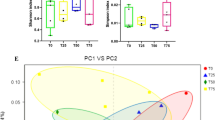Abstract
The objective of this study was to investigate the ruminal bacterial communities as affected by monensin, haylage, and their interaction of feedlot cattle fed 60 % dried distillers grains with solubles in a replicated 4 × 4 Latin square design. Pyrosequencing analysis of the V1–V3 region (about 500 bp) of 16S rRNA gene from the four dietary treatments (3 treatment plus one control diets) collectively revealed 51 genera of bacteria within 11 phyla. Firmicutes and Bacteroidetes were the first and the second most predominant phyla, respectively, irrespective of the dietary treatments. Monensin supplementation decreased the proportion of Gram-positive Firmicutes while increasing that of Gram-negative Bacteroidetes. However, the monensin supplementation did not reduce the proportion of all genera of Gram-positive bacteria placed within Firmicutes and lowered that of some genera of Gram-negative bacteria placed within Bacteroidetes. Haylage supplementation appeared to attenuate inhibition of monensin on some genera of bacteria. Factors other than monensin and haylage could affect ruminal bacterial communities.


Similar content being viewed by others
References
Barton LL, Fauque GD (2009) Biochemistry, physiology and biotechnology of sulfate-reducing bacteria. Adv Appl Microbiol 68:41–98
Bekele AZ, Koike S, Kobayashi Y (2010) Genetic diversity and diet specificity of ruminal Prevotella revealed by 16S rRNA gene-based analysis. FEMS Microbiol Lett 305:49–57
Callaway TR, Edrington TS, Rychlik JL, Genovese KJ, Poole TL, Jung YS, Bischoff KM, Anderson RC, Nisbet DJ (2003) Ionophores: their use as ruminant growth promotants and impact on food safety. Curr Issues Intest Microbiol 4:43–51
Caporaso JG, Kuczynski J, Stombaugh J, Bittinger K, Bushman FD, Costello EK, Fierer N, Pena AG, Goodrich JK, Gordon JI, Huttley GA, Kelley ST, Knights D, Koenig JE, Ley RE, Lozupone CA, McDonald D, Muegge BD, Pirrung M, Reeder J, Sevinsky JR, Turnbaugh PJ, Walters WA, Widmann J, Yatsunenko T, Zaneveld J, Knight R (2010) QIIME allows analysis of high-throughput community sequencing data. Nat Methods 7:335–336
Coleman GS (1960) A sulphate-reducing bacterium from the sheep rumen. J Gen Microbiol 22:423–436
Edgar RC (2010) Search and clustering orders of magnitude faster than BLAST. Bioinformatics 26:2460–2461
Edgar RC, Haas BJ, Clemente JC, Quince C, Knight R (2011) UCHIME improves sensitivity and speed of chimera detection. Bioinformatics 27:2194–2200
Felix TL, Loerch SC (2011) Effects of haylage and monensin supplementation on performance, carcass characteristics, and ruminal metabolism of feedlot cattle fed diets containing 60% dried distillers grains. J Anim Sci 89:2614–2623
Gould DH (1998) Polioencephalomalacia. J Anim Sci 76:309–314
Howard BH, Hungate RE (1976) Desulfovibrio of the sheep rumen. Appl Environ Microbiol 32:598–602
Huws SA, Kim EJ, Lee MR, Scott MB, Tweed JK, Pinloche E, Wallace RJ, Scollan ND (2011) As yet uncultured bacteria phylogenetically classified as Prevotella, Lachnospiraceae incertae sedis and unclassified Bacteroidales, Clostridiales and Ruminococcaceae may play a predominant role in ruminal biohydrogenation. Environ Microbiol 13:1500–1512
Johnson KA, Johnson DE (1995) Methane emissions from cattle. J Anim Sci 73:2483–2492
Kim M, Morrison M, Yu Z (2011) Phylogenetic diversity of bacterial communities in bovine rumen as affected by diets and microenvironments. Folia Microbiol (Praha) 56:453–458
Kim M, Morrison M, Yu Z (2011) Status of the phylogenetic diversity census of ruminal microbiomes. FEMS Microbiol Ecol 76:49–63
Kim M, Yu Z (2014) Variations in 16S rRNA-based microbiome profiling between pyrosequencing runs and between pyrosequencing facilities. J Microbiol. (in press)
Kung L, Bracht JP, Tavares JY (2000) Effects of various compounds on in vitro ruminal fermentation and production of sulfide. Anim Feed Sci Tech 84:69–81
Nelson M (2011) An integrated investigation of the microbial communities underpinning biogas production in anaerobic digestion systems. Ph. D. dissertation, The Ohio State University
Quinn MJ, May ML, Hales KE, DiLorenzo N, Leibovich J, Smith DR, Galyean ML (2009) Effects of ionophores and antibiotics on in vitro hydrogen sulfide production, dry matter disappearance, and total gas production in cultures with a steam-flaked corn-based substrate with or without added sulfur. J Anim Sci 87:1705–1713
Reeder J, Knight R (2010) Rapidly denoising pyrosequencing amplicon reads by exploiting rank-abundance distributions. Nat Methods 7:668–669
Russell JB, Strobel HJ (1989) Effect of ionophores on ruminal fermentation. Appl Environ Microbiol 55:1–6
Stahl DA, Flesher B, Mansfield HR, Montgomery L (1988) Use of phylogenetically based hybridization probes for studies of ruminal microbial ecology. Appl Environ Microbiol 54:1079–1084
Thoetkiattikul H, Mhuantong W, Laothanachareon T, Tangphatsornruang S, Pattarajinda V, Eurwilaichitr L, Champreda V (2013) Comparative analysis of microbial profiles in cow rumen fed with different dietary fiber by tagged 16S rRNA gene pyrosequencing. Curr Microbiol 67:130–137
Wang Q, Garrity GM, Tiedje JM, Cole JR (2007) Naïve Bayesian classifier for rapid assignment of rRNA sequences into the new bacterial taxonomy. Appl Environ Microbiol 73:5261–5267
Wedegaertner TC, Johnson DE (1983) Monensin effects on digestibility, methanogenesis and heat increment of a cracked corn-silage diet fed to steers. J Anim Sci 57:168–177
Weimer PJ, Stevenson DM, Mertens DR, Thomas EE (2008) Effect of monensin feeding and withdrawal on populations of individual bacterial species in the rumen of lactating dairy cows fed high-starch rations. Appl Microbiol Biotechnol 80:135–145
Yu Z, Morrison M (2004) Improved extraction of PCR-quality community DNA from digesta and fecal samples. Biotechniques 36:808–812
Zened A, Combes S, Cauquil L, Mariette J, Klopp C, Bouchez O, Troegeler-Meynadier A, Enjalbert F (2012) Microbial ecology of the rumen evaluated by 454 GS FLX pyrosequencing is affected by starch and oil supplementation of diets. FEMS Microbiol Ecol 83:504–514
Acknowledgments
The work was partially supported by an OARDC award (2010-007).
Author information
Authors and Affiliations
Corresponding author
Electronic supplementary material
Below is the link to the electronic supplementary material.
Rights and permissions
About this article
Cite this article
Kim, M., Felix, T.L., Loerch, S.C. et al. Effect of Haylage and Monensin Supplementation on Ruminal Bacterial Communities of Feedlot Cattle. Curr Microbiol 69, 169–175 (2014). https://doi.org/10.1007/s00284-014-0564-1
Received:
Accepted:
Published:
Issue Date:
DOI: https://doi.org/10.1007/s00284-014-0564-1




